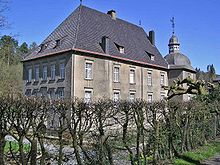Neuenhof Palace
The Neuenhof Castle is one of the art history and the city's history outstanding monuments Lüdenscheid . The moated castle is located in the south of the city in the Elspetal. A signposted road leads off the B 229 . Since the plant is inhabited by the owner Alhard Graf von dem Bussche-Kessell , the interior cannot be visited.
history
The castle was first mentioned in a document in 1326. Other documents and Neuenhof's location on a long-distance path suggest that it was originally a fortified castle . Archaeological finds from 1981 show that a medieval castle already occupied the place of today's moated castle. Shards of utensils from the 14th century were found directly on the foundations in today's moat. In 1643 the main building of the castle was rebuilt. This took place partly on the foundations of the medieval predecessor building. In 1693 the main house was badly damaged by fire. The reconstruction including various extensions took place until 1695. The outer walls of the building from 1643 were reused as inner walls, and the corner pavilions or towers on the east side were built. Numerous other structural changes took place in the 18th century. In 1746, the striking central projection between the towers was created. The last significant stage in building history was the rebuilding of the northern bailey in 1808.
The castle is the ancestral seat of the von Neuhoff family . The last name bearer on site, Elisabeth Josina von Neuhoff, married Baron Friedrich Wilhelm Leopold Christian von Bottlenberg , a member of a Bergisch noble family , in 1714 . Josine's grandfather, Steffen von Neuhoff (1608–1671), had the first post-medieval building built in 1643. The last von Bottlenberg, who lived permanently at Neuenhof, died unmarried in 1820. His heir was Julius Clamor Freiherr von dem Bussche-Ippenburg , raised in 1840 by the Prussian king to Count von dem Bussche-Ippenburg called von Kessell . His descendants no longer resided in Neuenhof until the 1970s, but at Ippenburg Castle .
Prisoners of war and forced laborers were housed in the forestry of Neuenhof Castle in 1943 and 1944 and, according to later testimony, treated inhumanely. After the Second World War, large parts of the manor were confiscated by the Belgian military command for many years. Otherwise, the civil use was limited to forest management and agriculture. In the southern economic wing there were cowsheds in which long-term preferred milk was produced. Only in 1974 did Alhard Graf von dem Bussche-Kessell move into the castle again permanently.
description
The main building is a rectangular two-storey cube, the courtyard side of which is flanked by two towers with curved domes. In the middle between the towers a gable with a large carved coat of arms represents the outstanding decorative element. It is the wedding table of the aforementioned Elisabeth Josine von Neuhof and Wilhelm Christian von Bottlenbergs from the year 1714. (The original has been hanging in Altena Castle since 1949 ) The main building, surrounded by moats, is preceded by a court of honor with flanking farm buildings from the 18th and 19th centuries. A richly decorated wrought-iron gate system at the eastern end of the courtyard is remarkable. Comparably representative systems are rather rare in southern Westphalia.
Osemundhammer
Recently, the public has been drawn to Neuenhof Palace in connection with industrial archaeological finds. The finds point to an iron production probably operated by the local landlords.
The remains of an Osemundhammer can still be seen today directly below the palace complex . a. in the form of former reservoirs. The facility they testify is probably one of the oldest known in the Lüdenscheid area. Historical records of the hammer go back to the time after the Thirty Years War , that is to the middle of the 17th century. However, the new finds show that the history of iron smelting and processing here goes back to at least the 14th century.
literature
- Alhard Freiherr von dem Bussche-Kessell: Neuenhof moated castle . Münster 1983. (= Westfälische Kunststätten, issue 26)
- Heimatbund Märkischer Kreis: Art and historical monuments in the Märkischer Kreis . Edited by Ulrich Barth, Ehnar Hartmann, August Kracht. 1st edition, Balve 1983, ISBN 3-89053-000-1 , pages 400-404.
Individual evidence
- ↑ Alhard Frhr. von dem Bussche-Kessel, p. 4
- ↑ Heimatbund Märkischer Kreis: Art and historical monuments in the Märkischer Kreis , p. 401
- ↑ Heimatbund Märkischer Kreis: Art and historical monuments in the Märkischer Kreis , p. 402
- ↑ Alhard Frhr. von dem Bussche-Kessel, p. 6ff.
- ↑ Heimatbund Märkischer Kreis: Art and historical monuments in the Märkischer Kreis , p. 402
- ^ Matthias Wagner: "Arbeit macht frei", forced labor in Lüdenscheid 1939 - 1945, Lüdenscheid 1997, p. 40
Web links
Coordinates: 51 ° 11 ′ 55.3 " N , 7 ° 37 ′ 45.3" E


